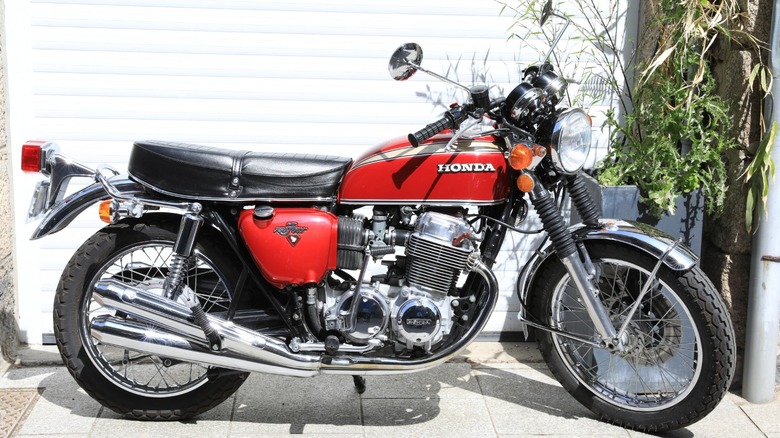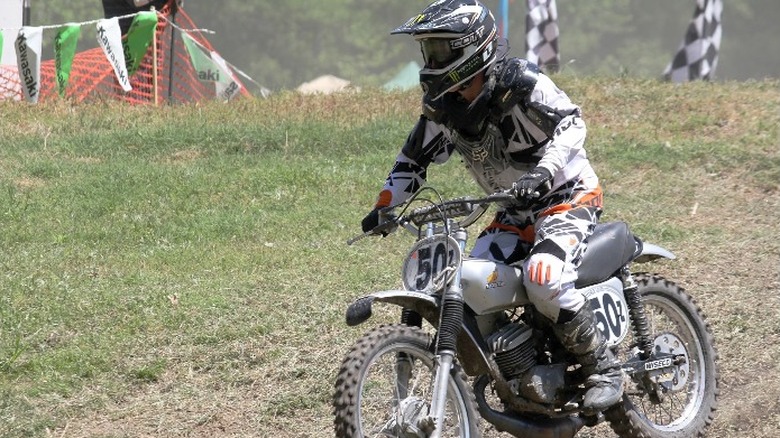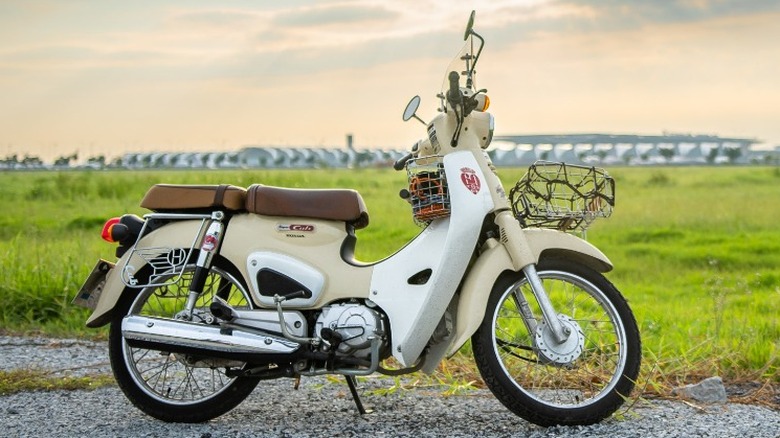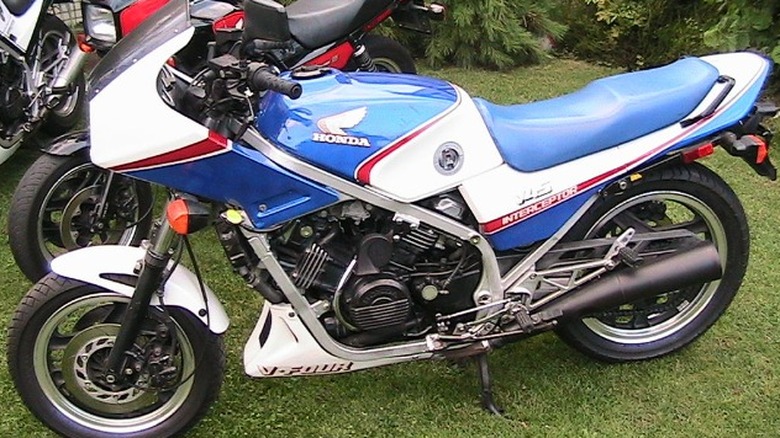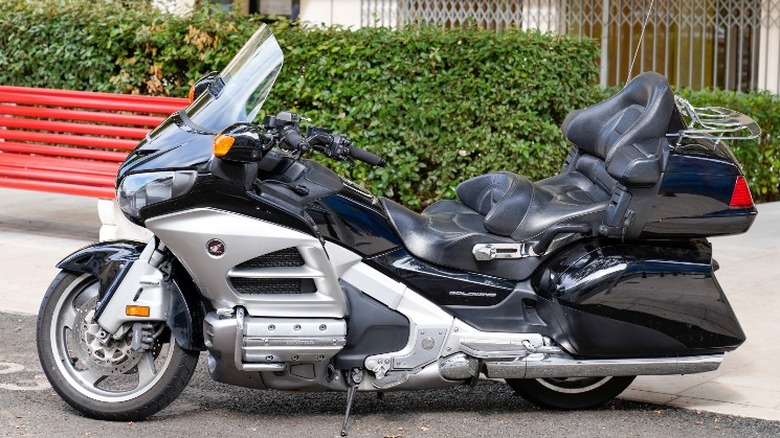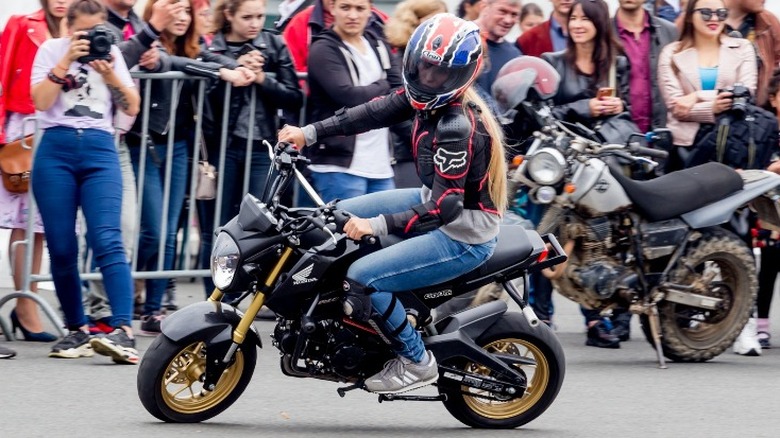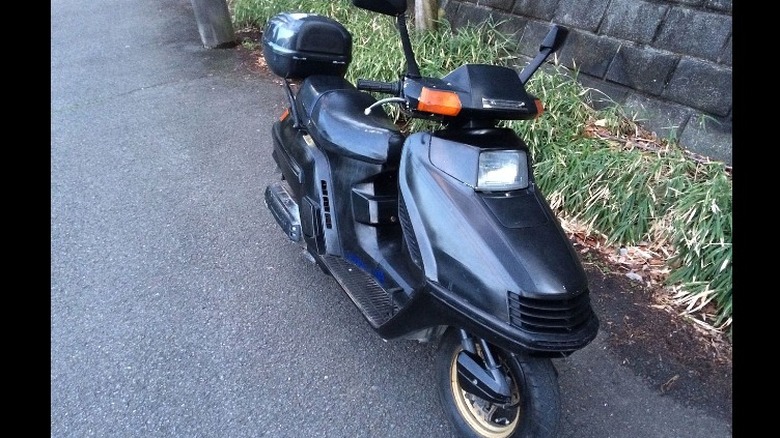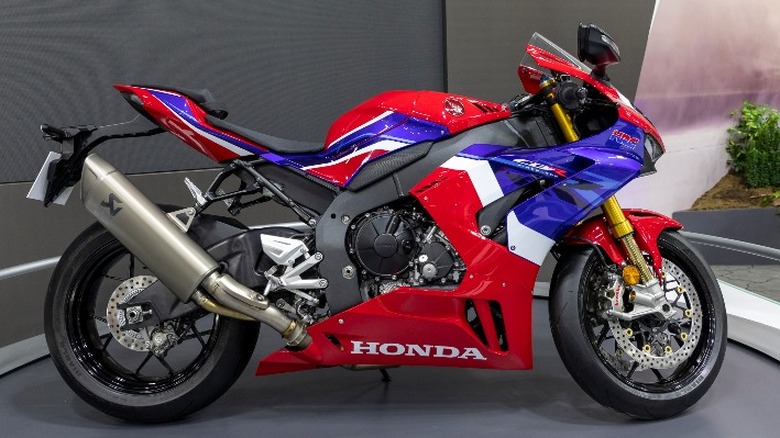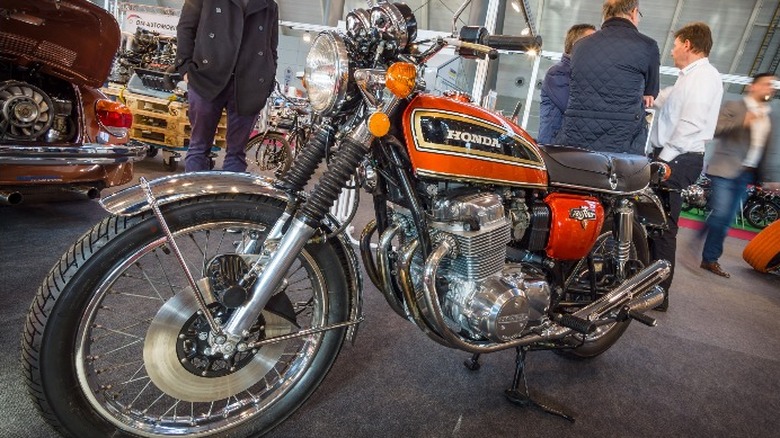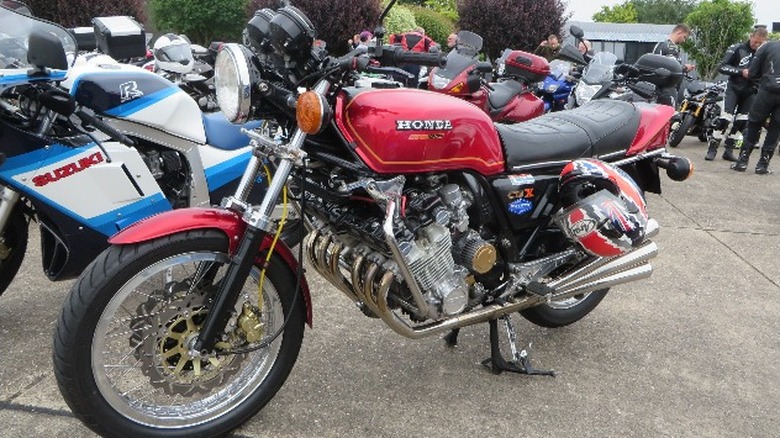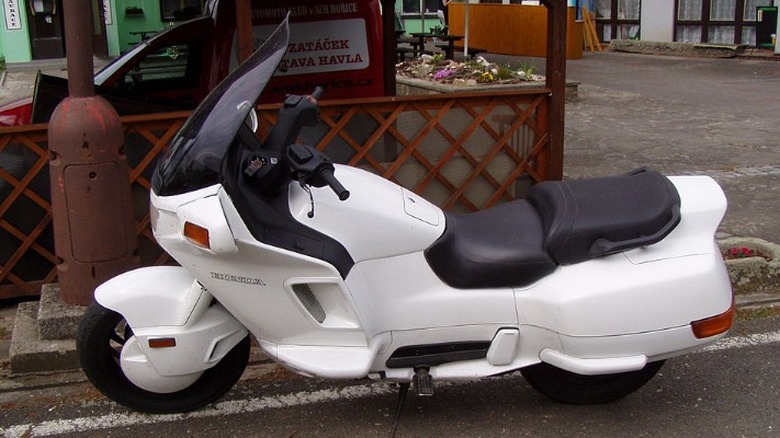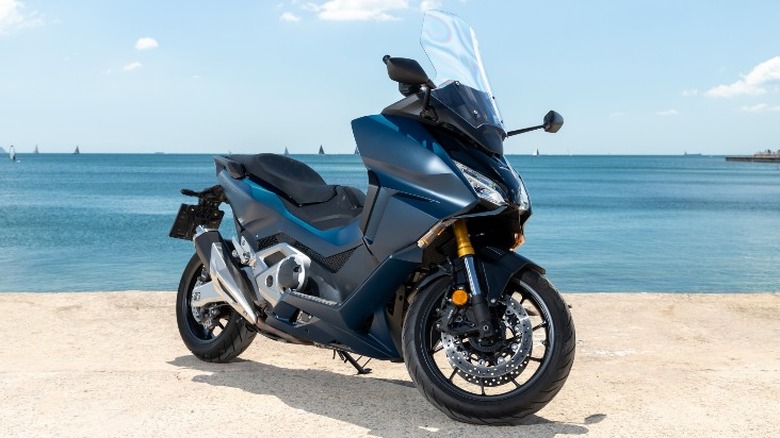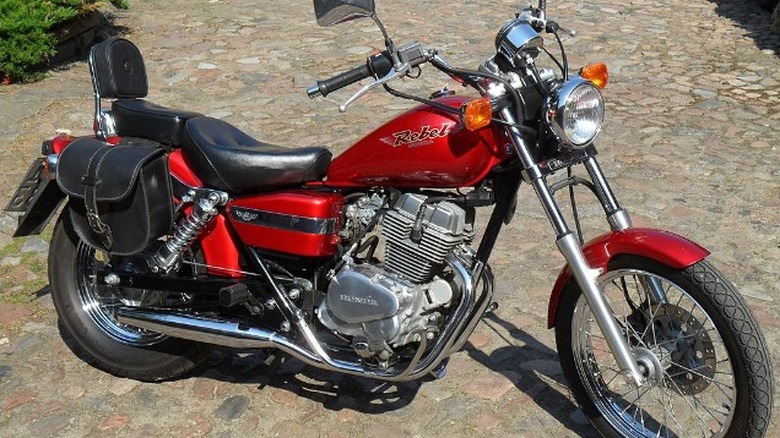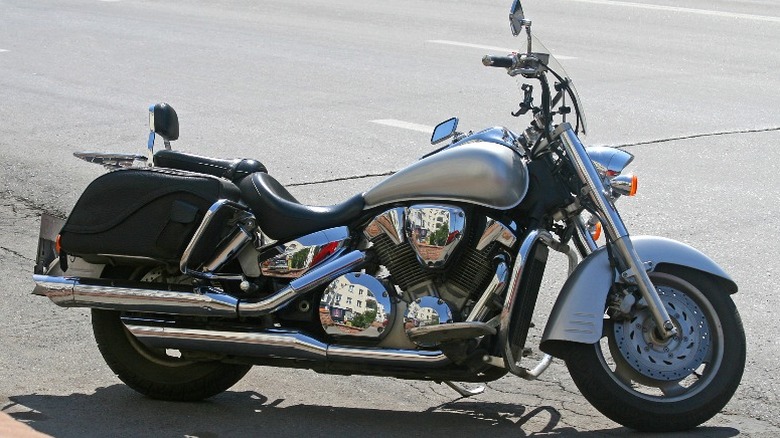The 13 Best Honda Motorcycles Ever Made
Japanese industry leader Honda has been producing a long list of motorized products and exporting them to the U.S. for more than 50 years now, and it has established its name as synonymous with reliability. While its cars are extremely popular, regularly topping sales charts, it may be even better known for the fantastic motorcycles rolling off assembly lines for decades now. Honda got its start by selling a small, affordable, and unassuming motorcycle in this country and transformed the way the public looked at cycles, opening up the market to a wider base of possible buyers than ever.
"You meet the nicest people on a Honda" is what advertisements of the early '60s proclaimed. This was a paradigm shift from the image of the rough and tumble biker Americans saw in the Marlon Brando hit film, "The Wild One." Barging diminutive and efficient motorcycles made it easy for novice riders who might have trouble handling a large and finicky Harley-Davidson or Triumph. Early motorcycles also established Honda's reputation for build quality, as they required little regular maintenance and repairs were rare. Over the years, dozens of great bikes have come from the company, winning over fans and loyal riders from all over. While looking through the history of Honda models, excluding machines made specifically for racing, these 13 models of motorcycle demonstrate Honda at its best.
Honda CR250M Elsinore
While Honda's early bikes were made for the street, the popularity of dirt bikes grew exponentially in the '60s and Honda created a few machines to get in on the action. This period saw dirt bikes coming from all over the globe with manufacturers competing for business, including Yamaha and Suzuki from Japan, but also European companies such as Czech CZ, Austrian KTM, and Italian Ducati.
Among the many great bikes Honda produced was the race-winning CR250M Elsinore, named for the California Elsinore GP racing series. Honda had previously only built four-stroke engines and attempted to use them in off-road machines. Dismal failures of these bikes in competition led Honda to ditch the effort and start making two-stroke engines. It debuted as a 1973 year model and was the lightest motocross bike available at the time (via Motocross Action Mag). Furthermore, it excelled by being user-friendly, comfortable, and well-built. The high-quality materials used in construction set benchmarks other manufacturers would follow. In 1979, the CR250M became the first product manufactured by Honda in Ohio at the then-new Marysville assembly plant still in use today. Today, Elsinores are highly coveted by collectors, but can still be picked up at auction for a reasonable $6,000.
Honda Super Cub
When Honda said you meet the nicest people, they were mostly referring to people on a Super Cub, renamed the C50 for the U.S. Honda's Super Cub was an original idea when first conceived and Honda sought to differentiate its product by making a motorcycle that was capable and easy to use while hiding the ugly bits normally exposed on larger bikes. According to Web Bike World, its success was immediate and the company went through growing pains immediately as its popularity exploded. After an initially slow start to its American operations, Honda employed the "Nicest People" ad campaign, causing sales to skyrocket almost overnight, and cementing Honda's place within the American market, opening the doors for its automobile business a few years later.
The Super Cub is still one of Honda's most popular products. It is sold all over the planet and provides primary transportation to tens of millions of people, particularly in areas of less affluence. And, for all the talk of the record numbers of Model T and Volkswagen Beetle units sold, the Super Cub may be the best-selling vehicle of all time, with an impressive 100 million units sold as of 2017.
Honda V45 Interceptor
The 1980s was a time of flux for the motorcycle market. Computer-aided design and advancements in engineering went hand in hand with the changing styles and attitudes of the period. The raw, classic look of the '70s gave way to the techno-futuristic look that dominated the '80s, and motorcycle design was not left out. This confluence of ideas led to the advent of super-fast motorcycles appearing on the roads with full fairings in bright colors. And Honda's V45 Interceptor is one of the best examples of this trend.
The V45 Interceptor benefits directly from Honda's racing program where it developed its V4 engine architecture. According to Hemmings, this engine came out in a 750cc displacement to conform to the AMA rules for its Superbike class. Further rules mandated the racing bikes utilized the same chassis as road-going versions, thus the V45 rides on the same steel tubes. Everything else about the consumer model comes from the racing development team and makes it the superstar that it was back in the early '80s.
Although this was at the top of its game back in 1983, it could not come close to keeping up with the bikes coming out today. It still offers great performance in a tight-handling package. The good news for enthusiasts is that they are very affordable, with excellent examples selling for under $4,000.
[Featured image by Nedhills via Wikimedia Commons | Cropped and scaled | CC BY-SA 3.0]
Honda Gold Wing
Honda's Gold Wing models have dominated the market for luxury touring bikes for decades. First introduced for the 1975 model year per Rider Magazine, the Gold Wing came out with a 999cc horizontally opposed 4-cylinder engine, which is ideal for a heavy motorcycle because it lowers the center of gravity, making it easier to manage. The first model was much more basic than what is seen today, but it established Honda's ability to produce a larger and more comfortable machine for long-distance riding.
Subsequent years saw the size of the Gold Wing increase both in physical dimensions and engine size, with the most recent model featuring a 6-cylinder 1,832cc engine. Gold Wings received fairings, rear and side cases, and broad, comfortable seats to create the most pleasant touring experience possible. Other improvements added over the years include ABS braking, an electric reverse gear, audio system with integrated intercom, load-leveling suspension, airbag, and automatic DCT transmissions, among dozens of other improvements, per Motorcyclist. These bikes are impressive.
Honda's level of quality and sophistication for the Gold Wing sets the bar high for its competition. And with Honda's reputation for reliability, the Gold Wing is an easy choice for anyone wanting a big bike for the highway.
Honda GROM
The American motorcycle market has always been skewed toward larger and heavier bikes while in much of the rest of the world, particularly in Asia, small machines rule the road. That is why it was so refreshing to see Honda put its efforts into bringing a fun, toy-like, and affordable bike perfect for city dwellers who rarely need to hit the open road or travel above 40 mph.
The GROM first hit the streets in 2014 with a very affordable $2,999 price tag. The current model is powered by a 125cc engine with 5-speed transmission and its price has only crept up by $300. Rider Magazine notes that the most recent model has been made by Honda to be easily customized and that riders have flocked to dealers to pick up these little bikes to apply their own personal touches. Indeed, the GROM has soundly bucked the notion that Americans only want big bikes, as it has been Honda's best-selling model since its introduction.
The long and short of it is that GROMs are irresistibly fun. They will never work in rural settings where daily jaunts on state highways are a part of life, but in tightly packed cities with the ever-present problems of traffic and congestion, a GROM is ideal.
Honda Elite 250
Honda has offered scooters with its motorcycle lineup for many years, although they have never been a large part of the business. It produced the Juno scooter in the '50s but abandoned the format in favor of its successful Super Cub. However, the '80s saw Honda bringing in a line of scooters called Elite that came in various engine sizes, the greatest of which is the Elite 250.
The Elite 250 of the mid-'80s was, according to the Lane Motor Museum, the supposed grandfather of the maxi-scooter, the large displacement (up to 650cc) scooters available today. With its 250cc single-cylinder engine, it is capable of cruising comfortably at up to 75 mph. The Elite 250 is also a larger machine than most typical scooters but remains small enough to be nimble and easy to manage through traffic. It also benefits from a roomy seat with sufficient padding to create a comfortable ride. A Bikez review proclaims the Elite to be even more comfortable than much newer maxiscooters and that its off-the-line acceleration is fantastic.
Even though the Elite 250 was only offered in the U.S. for five years, it was here long enough to leave an impression on scooter lovers all over and it is still probably the best scooter over anything else made in the '80s.
[Featured image by Ryuki8409 via Wikimedia Commons | Cropped and scaled | CC BY-SA 4.0]
Honda CBR1000RR-R Fireblade
Having built and exported the first of the CBR line in 1987 with the CBR600 (via Motorcycle News), Honda knows how to build a bike that can move fast ... very fast. The 600 proved to be a successful model for the company and continued to be improved and enlarged in successive generations until we have the absolute screamer available today. The Fireblade moniker was first affixed to a Honda motorcycle in 1992 with the first of a series of 900cc machines that proved to be road-legal bikes only slightly removed from racing models winning checkered flags (via Pevensey Honda U.K.).
The newest 1,000cc Fireblade from Honda does not come cheap at $28,900, but it delivers the best in engineering and technology available from Honda on two wheels. Honda lists the Fireblade as having a high 13:1 compression 999cc engine with four valves per cylinder and is built with dimensions drawn from MotoGP racing experience. Its fork is an electronically controlled Öhlins unit with the rear suspension coming from the same supplier. The muffler is a super lightweight titanium unit and the total weight of the Fireblade is just 445 pounds wet. All of this combines to make a 215 horsepower hell-on-wheels machine that is fit to terrify all but the most experienced riders to take it on, and Web Bike World says that while other motorcycles in its class have more power, the Honda makes up for it with its impressive technology.
Honda CB750
Long before Honda created the Fireblade, there was the CB750, which many at the time dubbed a "superbike." While it pales in comparison to modern superbikes, it excelled in its time and continues to be a desirable vintage bike today. The CB750 showed up in 1969 to compete with the larger motorcycles found on American roads. The first of them are referred to as "sandcast" models due to the older engine casting method used, according to Silodrome. However, demand quickly outstripped supply and Honda switched to the more modern die-cast method to keep up. This bike was so popular, other Japanese companies quickly followed in Honda's footsteps with large bikes, and the automotive press at the time coined the word superbike to describe it.
Honda engineered the bike, according to the manufacturer, expressly to compete with the then-new Triumph 750cc triple in the American market, as large displacement bikes were almost non-existent in Japan. The first model, dubbed Dream 750 FOUR, used a unique quad-pipe configuration for the exhaust to develop an association with the racing machines of MotoGP. Furthermore, Honda worked to get the ergonomics right, ensuring its new large motorcycle would perform and be comfortable at the same time.
Honda's meticulous plans to bring an overachieving motorcycle to market paid off. It received high praise in the media and spawned a generation of beloved now-classic bikes that are cherished to this day.
Honda CBX 1000
The first motorcycles ever made were not much more than a bicycle with a single-cylinder engine attached. Since then, the engines grew to have two, three, and four cylinders in a wide variety of sizes and arrangements. However, it was in the '70s that a few 6-cylinder machines showed up, but remained in a very small club. Honda entered this space in 1979 with the CBX 1000, a classic Japanese sport bike with a monster of an engine hanging out the sides.
According to Motorcyclist, Honda created this motorcycle for almost no other reason other than that it could. Four-cylinder 1000cc engines already existed, so why would it need two more cylinders? The truth of it is that Honda wanted a model that would impress the public and show what the company was capable of. It was a showpiece that could be bought and ridden.
To say that having six cylinders does nothing would be incorrect. Adding cylinders to an engine in the correct arrangement does reduce vibration, and the CBX 1000's engine is extraordinarily smooth running. Ultimate Motorcycling says that the CBX is quite capable with 105 horsepower and a top speed of 140 mph. The CBX continued to sell for four years and was affixed with a fairing and saddlebags to make it a sport tourer by the end. However, despite its impressive and imposing stature, sales never took off and the program ended after the 1982 model year.
Honda Pacific Coast
The Honda PC800 Pacific Coast is an unorthodox choice for a list of best motorcycles. It is routinely derided and lambasted by many motorcycle enthusiasts but possibly does not deserve it. The value of the Pacific Coast has to do with its intended purpose and target audience. It was never meant for seasoned riders with years of experience and possibly a bit of mechanical skill. The Pacific Coast was made to lure in new riders.
Debuting in 1989, the PC800 came styled fully encased by plastic panels that mimicked the look of automobiles of the day. Honda wanted a bike that was approachable for new riders and styled it to look much like the Accord or Civic they already owned. At its core, this motorcycle is a commuter bike. It features an 800cc liquid-cooled V-twin engine making around 50 horsepower, per Rider Magazine. It is a comfortable ride with many features to make it low maintenance. It is a fairly slow bike but has tremendous storage in the rear trunk, which gets exposed by lifting the entire rear section of bodywork, and it has a radio integrated into the front fairing and instrument panel.
In the end, Pacific Coast failed to sell in great numbers. They lack the size and power of touring bikes and lack the style and panache of most cruisers. It is now somewhat of an oddball of motorcycle history, but, for the right person, it can be a great ride. It is a comfortable around-town bike that can get someone going who desires comfort and practicality over speed.
[Featured image by Addvisor via Wikimedia Commons | Cropped and scaled | CC BY-SA 3.0]
Honda Forza 750
Most major motorcycle manufacturers have a couple of models of scooter, including smaller traditional bikes and a maxiscooter or two. These large scooters appeal to many riders who like to ride, but maybe appreciate the simplicity of having an automatic transmission, a lighter frame, and easy mounting. Honda's best entry into this category is the Forza 750, a 750cc twin-cylinder comfort cruiser.
The Forza 750 blurs the line between scooter and motorcycle as it is a substantial machine with capabilities exceeding many street bikes, and its features are first-class. With this bike, you get a fuel-injected twin coupled to Honda's DCT automatic transmission, according to Motorcycle News. Like other scooters, everything is mounted down low, keeping the center of gravity closer to the road. It also comes with keyless ignition, a large digital dash, and full connectivity with your smartphone. While it won't be beating any sport bikes in drag races, the 750cc engine provides ample power on-demand with every twist of the throttle. Like other scooters, the trunk below the seat is cavernous and, while it lacks a completely flat footboard, it is still easy to climb on and go.
While this scooter shows what a company like Honda can do with a larger format and modern technology, there is a huge drawback for residents of the U.S.: Dealers don't sell it. Scooters have failed to make significant sales gains in the American market and, quite often, the best models are out of reach.
Honda Rebel 250
Honda's Rebel line is the most basic entry-level available from the company. The Rebel 250 was produced by the company from 1985 to 2016, according to Timeless 2 Wheels, and has been a beginner bike of choice for millions of riders.
The Rebel is not a great bike by any metric. It uses basic technology and, by 2016, an ancient engine design. It came out year after year with only modest changes and improvements but continues to be found in dealers everywhere. What makes the Rebel a great bike is that it gets people riding. For people who love motorcycles, getting new riders is a joy. Not only do riders like to see others who enjoy it, but having more riders on the road increases overall visibility and possibly gets more drivers to notice them and prevent accidents. Maybe no statistical information confirms this idea, but it sounds plausible. Still, if Honda wants to sell its big and fast bikes, people need to start somewhere. If they have a good experience with a Honda Rebel, there is a good chance of selling them something else from the brand.
Another thing that gives the Rebel 250 a good placement among Honda motorcycles is that the Motorcycle Safety Foundation has used them for years in its rider training program. This comprehensive course teaches the basics of how to ride safely before going to the streets on a brand-new crotch rocket, something that can end in tragedy in a second.
[Featured image by M536 via Wikimedia Commons | Cropped and scaled | CC BY-SA 3.0]
Honda Shadow
Honda has spent decades coming out with new and innovative motorcycles, pushing the boundaries and often defining new categories within the industry. However, Honda is also a clever company keen on capitalizing on market trends. Such is the case with its Shadow line of cruisers. Even though Honda bikes have been well-built, capable, and reliable for decades, some buyers would never get one because of the styling. These buyers prefer the look of American V-twins but maybe could not afford them. That's where the Shadow steps in.
Honda first released its V-twin cruiser in 1983 with the Shadow 750. While the Regan administration imposed restrictions on motorcycle imports shortly after, Honda kept joining and brought in a 700cc model to come in under the guidelines, according to Timeless 2 Wheels. Honda's timing was good for this bike, as anyone who knows much about the history of American motorcycles knows the Harley-Davidsons of this period were of extremely poor quality and expensive, making a dead-reliable Honda an appealing alternative.
With nearly 40 years of production, it is safe to say that Honda made a good choice. The Shadow has seen changes in styling and mechanicals over the years, but its basic design and spirit have remained the same. The original models looked more like cruisers built with hallmark Japanese motorcycle characteristics, but the new ones are attractive machines with styling to match most any American V-twin, only the Honda gets a smooth and reliable water-cooled engine.
